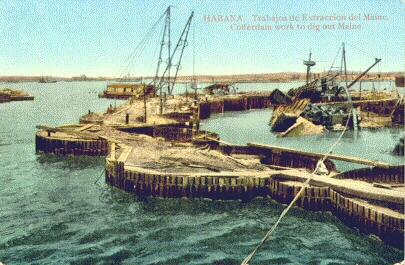

On August 5, 1910, the United States Congress finally authorized the raising of the remains of the USS MAINE. The Army Corps of Engineers was directed to supervise the work, which involved the building of a cofferdam around the sunken hulk, the pumping out of the water, and the removal of the wreck itself. Once the water was drained, but while the vessel was still in place, a second American court of inquiry would investigate the cause of the vessel's demise, and the remains of any sailors found would be removed to the United States and given a proper burial.

The MAINE within the cofferdam.
This work moved ahead, and by November 2, 1911, the hull was fully exposed. The remains of 36 crewmen were found in the wreckage. The second investigation into the sinking was concluded in December, 1911, and the raising of the USS MAINE could move into its final phase - the actual refloating of a portion of the wreck and the removal of the remaining relics of the ill-fated vessel. The foremast and mainmast were removed, as were other portions of the ship. The stern, the least damaged portion of the wreck, was made ready for refloating. A temporary bulkhead of wood and concrete was built across the open, forward, end of the stern section. The bulkhead had doors that could be opened to permit water to flow in so the stern could be "buried at sea". Holes were made into the stern's hull, to enable water to be injected into the mud to release the vessel from the suction of Havana harbor's muddy bottom.The holes were outfitted with seacocks for future use in sinking the vessel.
On February 13, 1912, the vessel was considered to be ready, and water was allowed within the cofferdam. The vessel again began to float for the first time since the terrible night that it became a fiery coffin for 260 men, and the catalyst that sparked the Spanish American War. She was anchored to the cofferdam until the day of her final voyage.
On March 16, 1912, amidst somber cannon salutes and tolling bells, the USS MAINE, under tow from the tug OSCEOLA and several others, headed out to sea. To decrease pressure on the temporary bulkhead, the MAINE was towed stern-first, or backwards. She was followed by the USS NORTH CAROLINA, which held the flag-draped coffins of the 36 crewman who had been found aboard the MAINE's rusting hulk. The crewmens' remains were placed under the supervision of the their former chaplain, now monsignor, John Chidwick. Chidwick had presided over the funerals of their comrades fourteen years earlier.
The work crew was removed from the MAINE, and a solitary figure remained on board, dressed in a black suit. The figure was that of "Dynamite Johnny" O'Brien, an early arms smuggler/supplier for the Cuban Insurrectionists, adventurer, and now a respected member of the Corps of Port Pilots of Havana. A large U.S. flag was placed on a temporary mast, and the deck was strewn with roses. As the vessel moved, tens of thousands of silent people lined the waterfront. The MAINE passed between an honor guard of American and Cuban vessels with crews at attention. As the vessel approached open water, the band on the NORTH CAROLINA played somber music.
After journeying about four miles out to sea, beyond what was then the three mile limit, the small flotilla stopped. The work crew went back on board the USS MAINE, opened the seacocks and the gates in the temporary bulkhead. Slowly, very slowly, she settled in the water as the band on the NORTH CAROLINA played the "Star Spangled Banner." "Taps" was then played by a bugler. As she went down to the ocean bottom, six hundred fathoms below, air pressure exploded the her decks and spray shot into the air. The largest piece of the USS MAINE disappeared forever.
Even after the MAINE was sent to her final, watery grave, she still did not fully rest in peace, but rather in pieces. Portions of the MAINE actually began to be offered to the public at a very early time, even before she was raised. The 1903 Bannerman's catalog of military goods included not only cork life rings from the MAINE, which had been brought to New York after the disaster and then sold as surplus, but even included the one of the MAINE's capstans, and sections of cable from the vessel.
Once the vessel was raised, many more artifacts, formerly trapped beneath the wreck, came to light. These pieces, owned by the government, were given out to organizations and towns around the country for use in monuments. In this way, she is still remembered. Many people have had the strange experience of wondering in some aging park or forgotten cemetery in a landlocked portion of the country and stumbling upon a piece of the USS MAINE.
For information on where some of these parts ended up, and images of some of them now, click here!
Blow, Michael, A Ship to Remember , (New York: William Morrow and Company, Inc., 1992).
Ripley, Warren, "The Battery", Charleston, SC: Evening Post Publishing Co., 1977.

